Solana releases network performance report: Multiple new features are launched, TPS surges, network operates smoothly.
Recently, the Solana Foundation released the "Solana Network Performance Report". The report discloses a series of metrics related to the network status of Solana and reviews the operational status, performance parameters, and energy usage of the Solana network over the past half year or more.
In October 2022, Solana also released a previous report and solicited feedback from the community on that report. Regular disclosure is also seen as part of its transparency commitment.
According to this report, the network has maintained normal operation at 100% since February 25. Since December 2022, the average TPS has remained stable. The maximum TPS has been steadily increasing, significantly increasing in the second half of 2022.
In addition, Solana has launched several new features, including QUIC TPU, stake-weighted QoS, and localized fee markets, among others.
The launch of the new NFT technology structure "state compression" is particularly noteworthy, as this feature can significantly reduce the cost of minting NFTs by several orders of magnitude. Minting 100 million NFTs only requires 50 SOL. State compression was developed for NFTs but can be used for other applications, bringing more use cases to the Solana network.
April 2023, Helium Network successfully completed the migration to Solana Network, this process was smooth and seamless.
Following is the original report, translated by Odaily.
Summary
The performance of the Solana Network improved in the first half of 2023. Specifically, its condition is measured by parameters such as uptime, voting transaction ratio, block time, TPS, etc.
Since the last network performance report was released in October 2022, the Solana Network has undergone several major improvements, including:
v1.14 smoothly released on the mainnet. On February 25th (during the last software upgrade period), a network interruption occurred and an improvement measure was proposed for this. Since February 25th, the network has experienced 100% uptime.
Network upgrade to better handle high traffic. Introduced measures such as QUIC TPU, stake-weighted QoS, localized fee market, etc. The network has performed well during periods of high stress since the network upgrade (e.g. during the MadLads NFT minting).
Introduced state compression, a new method of storing data directly on-chain that reduces costs by several orders of magnitude. It now only costs 50 SOL to mint 100 million NFTs on Solana.
The Solana Network continues to be operated by a strong and independent set of validators from around the world. It is one of the most decentralized PoS blockchains in the world and one of the most advanced blockchains. Below, we provide some statistics tracked by the Solana Foundation to measure the decentralization and vitality of the Solana Network (data as of July 11th, 2023):
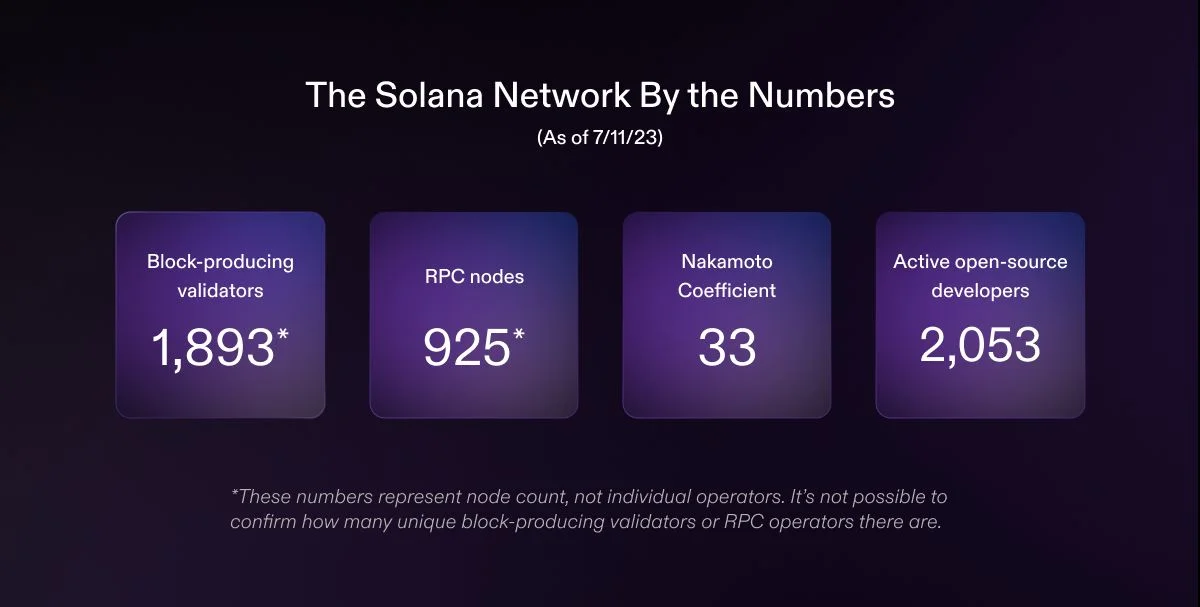
(Note: These numbers represent the number of nodes, not individual validators or RPC operators. The number of independent validators or RPC operators cannot be confirmed.)
Network Performance Overview
In order for a billion people to take advantage of the Solana network, users need to have confidence in the overall reliability of the network: the ability to access the network continuously, the accuracy of network-related information, transaction speed, and the security of funds and information.
The following are some metrics tracked by the foundation to understand how the network measures up to this objective. For simplicity, we focus on four metrics and allow users to easily track these metrics and their progress over time. These metrics, as well as other metrics, are included in the Dune dashboard for users to easily delve into the data layer or run their own analysis.
Uptime
A resilient network is the foundation for network trust and continuous growth. One of the most significant measures of reliability is network uptime.
We have snapshots of the network's monthly uptime, measured as the percentage of uptime for a given month in the past six months.
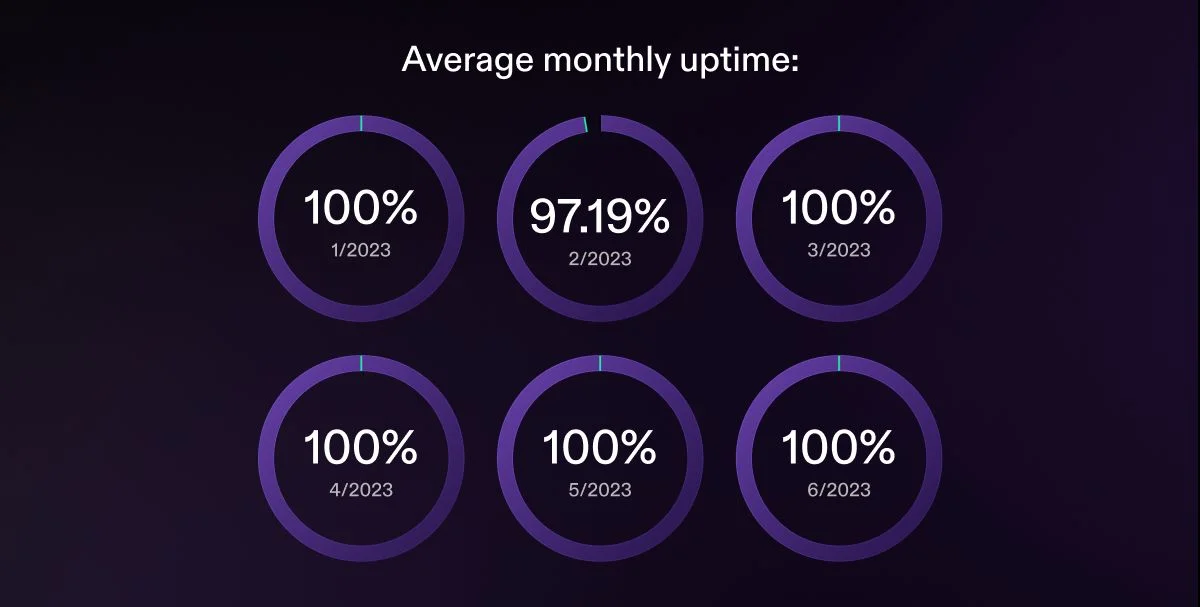
Voting Transaction Ratio
Voting transactions are necessary for the network's operation as they create the decentralized consensus upon which the blockchain relies. Voting transactions occur when validators vote to confirm one or more proposed blocks. Non-voting transactions are triggered by user actions on the blockchain. For example, non-voting transactions may represent NFT minting or users transferring tokens from one wallet to another. The network requires a certain number of voting transactions to achieve consensus, but over time, we expect to see a decrease in the ratio of voting to non-voting transactions as network efficiency improves.
The following is the ratio of voting to non-voting transactions in the past six months.
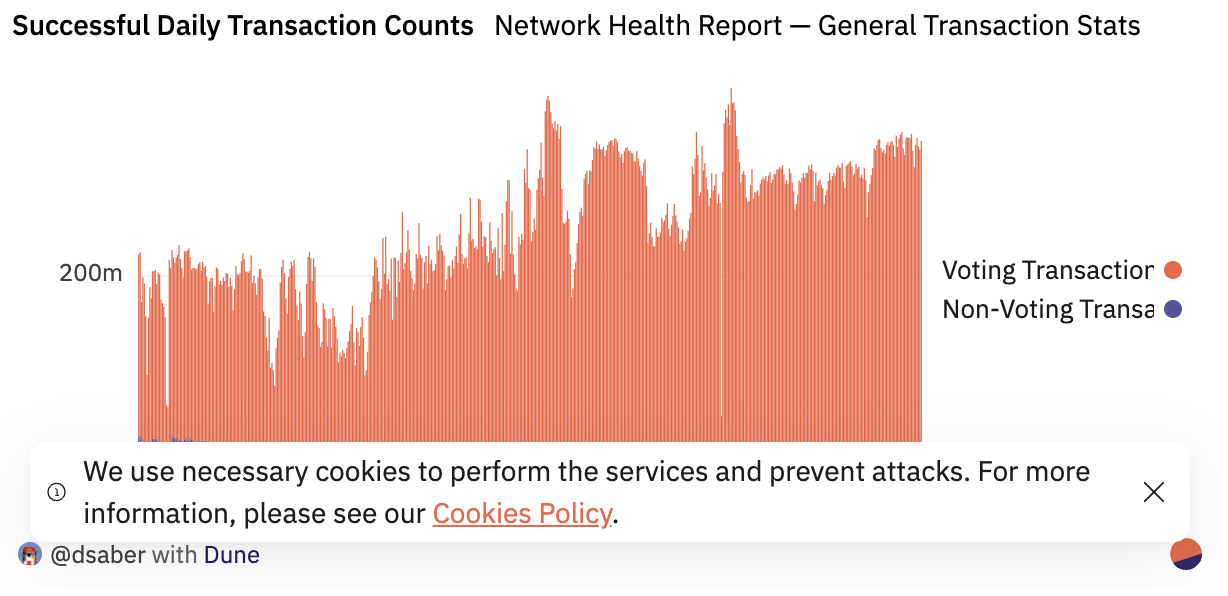
Block Time
Block time measures the speed of individual transactions as it measures the speed at which the network adds more "blocks" to the blockchain. In this chart, we see the average time it takes to generate blocks, the consistency of this metric, and how it changes over time.
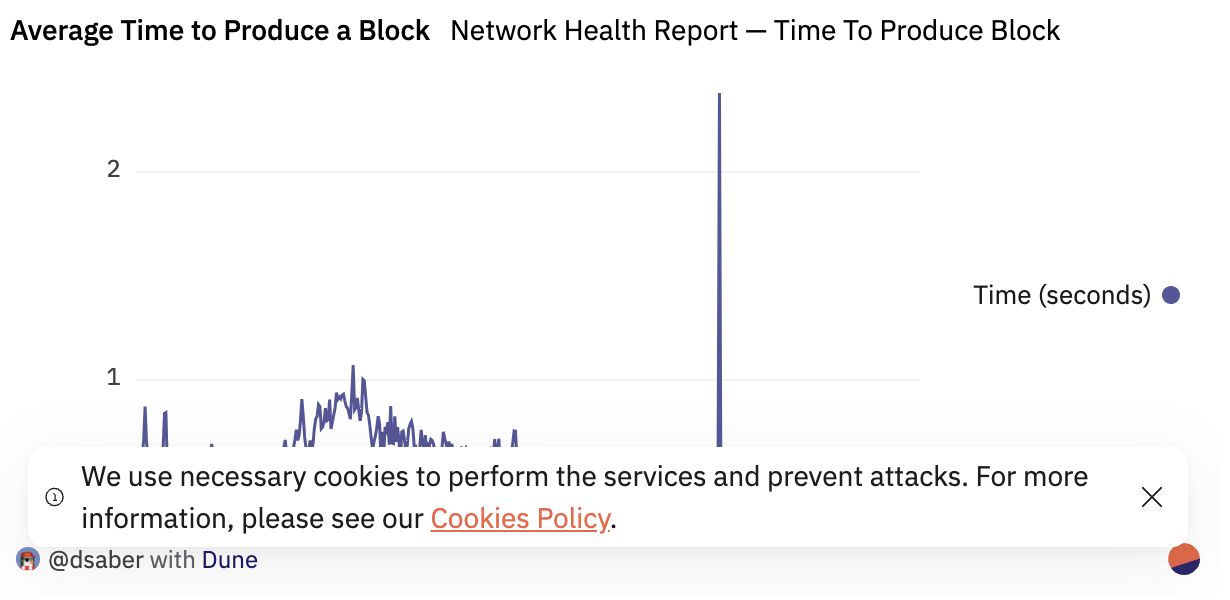
The peak at the end of February is related to network interruptions on February 25th.
Average and Maximum TPS (Transactions Per Second)
TPS accurately reflects the current throughput of the network and showcases its potential for growth over time. The benchmark is set at 65,000 transactions per second. Actual TPS will vary due to different combinations of complex transactions on the network and based on demand at any given moment. For example, purchasing NFTs is much more complex compared to simple transfers of native tokens between wallets.
Please note that TPS does not reflect network capacity but rather the demand for transaction volume. In almost all cases, the mainnet test version operates below capacity.
The following graph provides a snapshot of the network's real-time performance. It is divided into average TPS for a given date and maximum TPS, split by date. Since December 2022, the average TPS has remained relatively consistent with some fluctuations related to high network demand. The maximum TPS has been steadily increasing since January 2022, with a significant jump in the second half of 2022, which is related to the new network upgrades.
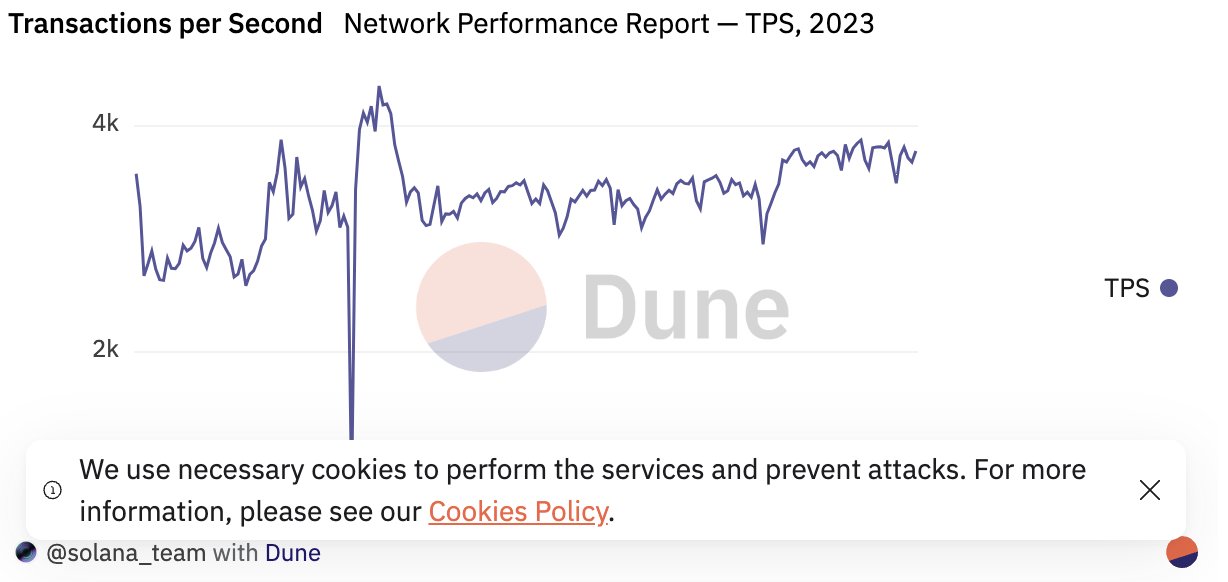
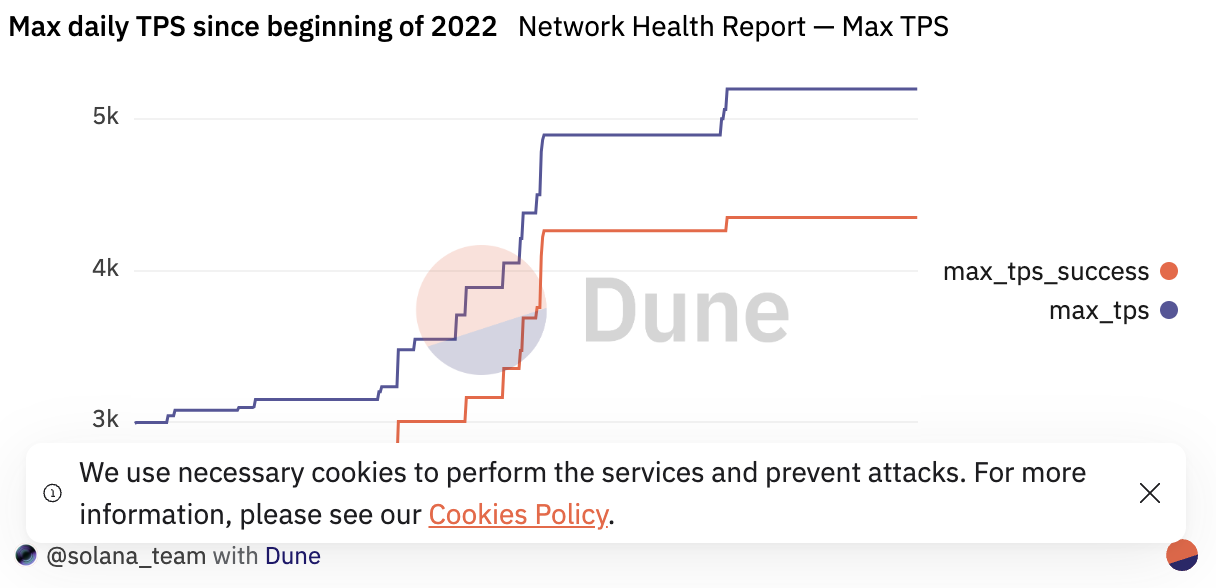
Network Highlights Since October 2022
In 2022, the Solana network experienced several slowdowns or interruptions during periods of high activity, such as during large-scale NFT minting. In response, core developers introduced network upgrades including QUIC, Stake Weighted QoS, and localized fee markets. Since the introduction of these upgrades, the network has performed well during periods of high stress, such as MadLads NFT minting. Developers are also continuing to test and develop other network upgrades and plans, including increasing the maximum transaction size (currently limited to 1232 bytes) and simplifying voting logic to reduce the total amount of data that needs to be transmitted and stored.
QUIC TPU: QUIC is a network protocol designed by Google for fast asynchronous communication with session and traffic control features. QUIC can be used to limit traffic from any participant, allowing the network to focus on genuine and effective transactions. QUIC has been added to the port that introduces user transactions.
Stake Weighted QoS: Stake Weighted QoS is used to allocate network bandwidth for leaders effectively. It does not accept transactions on a first-come, first-served basis but provides access to transmit information, so nodes with a 0.5% stake will have the right to transmit at least 0.5% of the packets to the leader. This can increase the resilience of the network by suppressing spam or malicious actors. Stake Weighted QoS has been added to the QUIC TPU port.
Localized Fee Market: The fee market provides users with a way to add additional fees to their transactions to express urgency compared to other transactions. The priority fee is calculated based on the computational resources expected to be required by the transaction. For example, a simple token transfer will have a lower total priority fee than a minting factory for NFTs expressing the same level of urgency. This process makes the market more efficient by allowing users to express urgency and prioritize transactions.
Improved Upgrade Process: To address the network interruption on February 25th, Solana Labs CEO Anatoly Yakovenko published a blog post proposing a new release process for software upgrades to make the upgrade process more resilient when facing network expansion. This includes involving additional external developers and auditors in the release process to test and identify vulnerabilities, improving server restart processes, emphasizing focus on network stability, and forming a countermeasure team. Some of these proposals have already been implemented, including:
Comprehensive upgrade process tested online: To simulate the upgrade process, the test network is now first downgraded to the previous software version and then simulates the software upgrade process that will be rolled out on the main network. Before this, the test network was a minor version of the main network during upgrades.
Optimization of tools for manual restart: For example, the initial design is in place, and it can automatically perform some more mechanical steps (SIMD 0046).
Adversarial testing is running on private clusters and test networks: These tests are currently being run on a temporary basis as core engineers are working on building a more formal testing plan. In this regard, Solana Labs' validator reference client now has adversarial ports, and core lab engineers are adding functionality to configure solutions for building adversarial testing.
Smooth release of 1.14.17: Version 1.14 was officially adopted on May 22, with over 66.6% of stakers upgrading to 1.14 at the time. This is the first major network upgrade since the interruption on February 25 and the launch of the aforementioned improvement upgrade progress. As of May 30, the 1.14 version of the Solana validator client has been adopted by 97.4% of shares on the Solana network.
Compression of NFT and state compression: Compressed NFT is now live on the Solana mainnet test version. Compressed NFT operations are cheaper than uncompressed NFT operations, reducing costs by 2400-24000 times. Minting 100 million NFTs on Solana now only requires 50 SOL. This new NFT technology structure is called "state compression." State compression unlocks many new use cases and expands the potential impact of blockchain by enabling NFTs for messaging or enhancing customer loyalty programs, among other use cases. State compression is developed for NFTs but can be used for other applications. In short, state compression involves storing some data on the blockchain that would otherwise be stored on each machine.
Smooth Helium migration: In April 2023, the Helium network successfully completed its migration to the Solana network, which was relatively seamless for Helium network participants and did not cause significant disruptions to the Solana network. Helium's migration utilizes state compression for minting NFTs, which is more efficient and cost-effective than other methods.
Other Updates on Firedancer: Firedancer is a Solana validator client developed by Jump Crypto and is adding and testing more components.
QUIC Implementation Demo: Firedancer recently did a high-performance QUIC implementation demo, which should bring more efficient data transactions.
Reed-Solomon Erasure Coding Release: Turbine is a mechanism in the validator responsible for distributing "shards" (block fragments) to other validators in the cluster. Reed-Solomon is an error-correcting coding scheme that helps accurately encode data in these shards and then transmit them to other validators.
Tinydancer: Tinydancer is the first lightweight client on Solana, developed as part of the Solana Foundation's Grizzlython Hackathon. The lightweight client is a software client that can run locally on simple devices like laptops, connecting to full nodes in the network to verify the ledger's state and check for invalid state transitions.
Real-Time Emissions Monitoring: In April 2023, Solana became the first major smart contract blockchain to measure carbon footprints in real-time. The independent startup TryCarbonara launched www.solanaclimate.com to track the network's impact.
Network Challenges Since October 2022
Since the last network performance report in October 2022, the Solana network experienced an outage. No user funds were affected in this incident.
February 2023 Interruption: On February 25th, the mainnet Beta began experiencing a prolonged block termination period. After investigation, the cause was traced back to several services running custom block forwarding software on the network, which inadvertently transmitted a large amount of data, equivalent to several orders of magnitude larger than regular blocks. The network's duplicate data elimination logic was unable to handle this situation, causing the Turbine protocol to become overloaded and significantly impairing network performance. After diagnosing this issue, core engineers created enhancements to the duplicate data elimination logic, which have now been implemented starting from Solana Labs validator clients v1.13.7 and v1.14.17. This will also be mitigated through long-term Solana protocol design changes, using QUIC to replace all UDP-based network protocols, which will better enforce constraints in Turbine. Read the full interruption report here.
Several proposed network upgrades have been implemented or are being rolled out to address the causes of this interruption, particularly QUIC, fee markets, and equity-weighted Quality of Service (QoS) implementation.
Upcoming Measures
Solana core developers have been working on several new network upgrades aimed at addressing the challenges posed by rapid user growth and adoption to strengthen the network.
These Solana Improvement Documents (SIMD) are proposed design documents on how to make changes to the network that require coordination across multiple core development teams. One recently accepted SIMD is SIMD-33: Just-in-time Voting Incentives, which rewards based on the number of slots voted on, providing more rewards for low-latency voting. This aims to reduce block finalization time and discourage intentional voting delays.
The latest version includes several network upgrades, but these features have not yet been activated. The new features can greatly improve network latency. The new version also allows users to undelegate staked nodes on the network, reducing slashing rates and improving performance. (Note: Undelegated stake accounts are still controlled by the original staker and can be freely re-delegated to active validators or withdraw their funds).
Users can continue to monitor the performance of the Solana network and contribute to tracking its development over time through Solana Network Reports.



